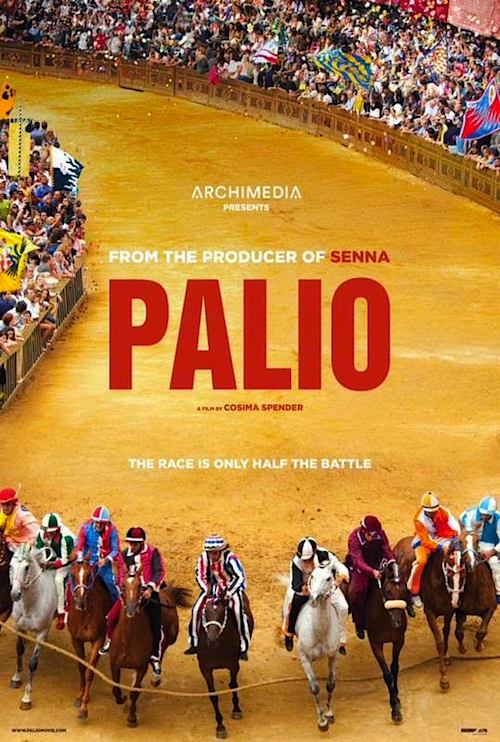By Joe Bendel. The world’s oldest continuous horse race is a full contact, bareback spectacle. The rules seem perversely designed to maximize acrimony and anarchy—and the good citizens of Siena’s seventeen districts would not have it any other way. Viewers experience all the longstanding personal rivalries and district grudges fueling the summer tradition in Cosima Spender’s amazing documentary Palio, which screens during the 2015 Tribeca Film Festival.
If you live in Siena, you identify with your district, rather than the city as a whole. Since at least the Fourteenth Century, they have held some form of the Palio di Siena. Every July 2nd and August 16th, the districts compete in a horse race staged in the ancient Piazzo del Campo. There are no saddles and essentially no rules. Jockeys are free to bash each other and their horses black and blue. However, unlike every other horse race in the world, if a jockey is knocked off his steed, the riderless horse can still win. Current dominant Palio champion Gigi Bruschelli notched a victory that way, which his many critics are quick to belittle.
 Bruschelli has amassed thirteen Palios in sixteen years. He has his sights set on Andrea “Aceto” de Gortes’ record of fourteen Palios. However, the Palio legend has formed an unlikely alliance with his former nemesis, Silvano “Bastiano” Vigni, who is training Bruschelli’s one-time protégé Giovanni “Tittia” Atzeni to unseat his old stable-master.
Bruschelli has amassed thirteen Palios in sixteen years. He has his sights set on Andrea “Aceto” de Gortes’ record of fourteen Palios. However, the Palio legend has formed an unlikely alliance with his former nemesis, Silvano “Bastiano” Vigni, who is training Bruschelli’s one-time protégé Giovanni “Tittia” Atzeni to unseat his old stable-master.
You might think you know horseracing from going to the Aqueduct, but the Palio is a completely different kettle of fish. Spender and cinematographer Stuart Bentley caught some absolutely jaw-dropping, up-close footage of horses crashing into the barrier wall and then careening back into the race. You can see the horses sweat and the men snarl. If you were to witness a Palio-style pile-up at an American track, you would expect to see the vet walk out with a shotgun. Yet, in Siena, everyone just shakes it off.
Yes, cornering is a bit of a challenge at the Palio, but perhaps even more mind-blowing, pay-offs and log-rolling are generally accepted parts of the game. It is common knowledge the other riders from Bruschelli’s stable are looking to cover his back, unless another district makes them a better offer. As a result, the behind-the-scenes intrigue is even more important than the action on the track.
Not so surprisingly, there is probably more trash-talking in Palio than any other sports doc one can think of. Like betrayal, it is a big part of the game. The old salty dogs Aceto and Bastiano are particularly good at it. Listening to them excoriate Bruschelli and needle each other is wickedly amusing. Yet, if you think they are harsh, wait till you hear some of the districts’ chants.
In many ways, the Palio is like stepping into the late Middle Ages. Visually, Spender’s Palio is a rich feast of chaos and color, vividly capturing all the traditional pomp as well as the bedlam on the track. There are real stakes to the narrative she chronicles and genuine roguish charm to her cast of characters. A documentary on Italian horseracing might sound like a decidedly specialized subject, but Palio is readily accessible and endlessly intriguing, in a stranger than fiction kind of way. In fact, it is so entertaining, it is even worth the time and hassle it takes to get to the Regal Battery Park. Highly recommended, Palio screens again Wednesday (4/22) and Saturday (4/25), as part of this year’s Tribeca Film Festival.
LFM GRADE: A
Posted on April 20th, 2015 at 4:41pm.